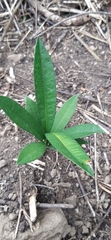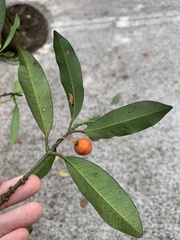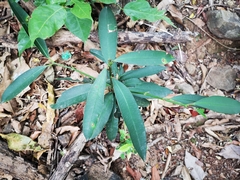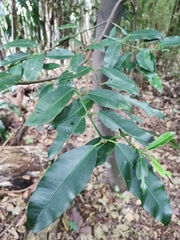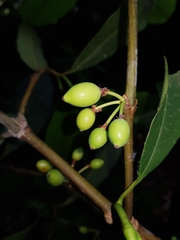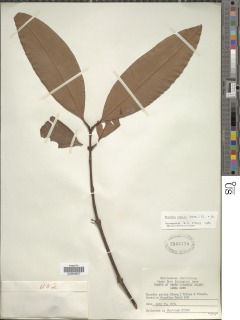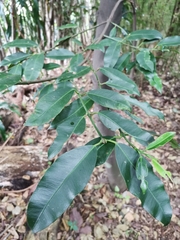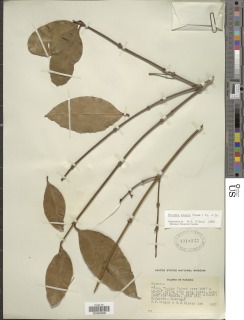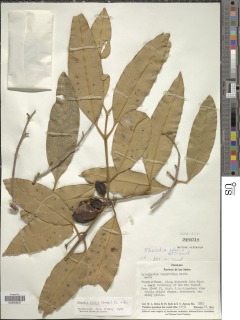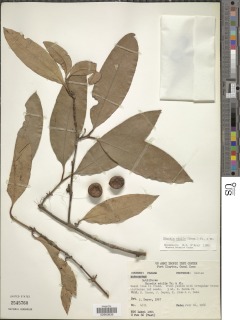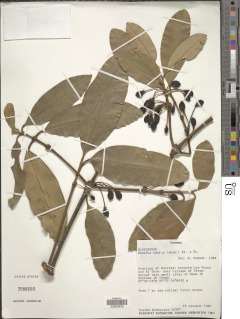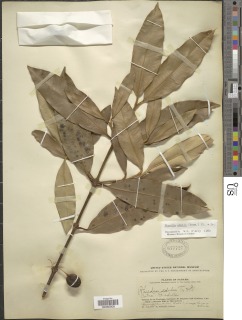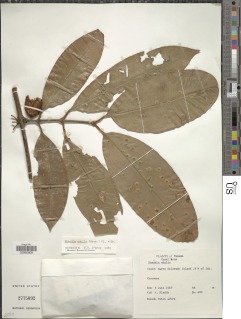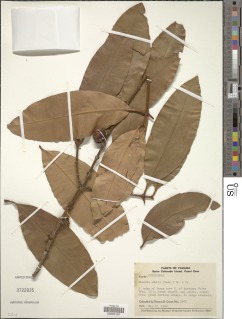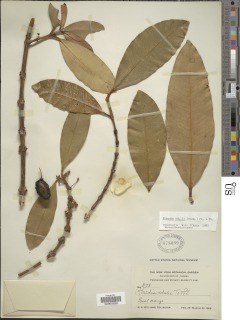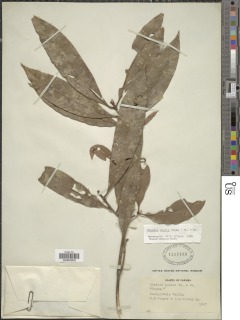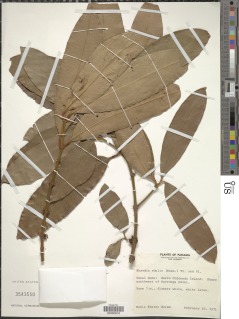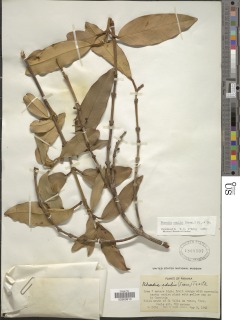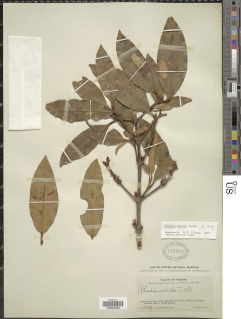

|
|
|
|
Family: Clusiaceae
chaparrón, more...madroño, sastra
[Rheedia edulis Planch. & Triana., moreRheedia tonduziana Engl.] |
Description: A medium-sized forest tree, not quite (or just barely) reaching the canopy, with a straight trunk and branches that arise regularly, straight and horizontal out of the trunk, opposite to one another. Leaves are opposite, oval, long, and have barely visible secondary veins that are straight and parallel. Breaking off a leaf produces a bit of whitish or cream-colored latex, as does cutting the bark. At the end of a branch, between the final leaf pair, is a crack which spreads when the two leaves are pulled apart (this is a good character of the genus Garcinia everywhere in the world). Reproduction: Flowers are white, produced in leaf axils all along the branches, from January to April, but are not conspicuous. Fruits are green and ovoid, become yellow with maturity, have two sections, both with a seed covered in a white aril; animal-dispersed. Distribution: Very common in the understory on BCI, as a sapling and tree; scarce in other forests from Gamboa to Santa Rita. Similar Species: The opposite, oval, rather long and narrow leaves, with faint parallel secondary veins, can be learned at a glance after seeing them often enough at BCI; check for the small crack between the terminal leaf paper while learning, or break off the leaf to look for the droplets of latex. The other LK gar2ma Garcinia, LK2 G. madruno is very similar in all these traits, but with yellowish latex. LK sympgl Symphonia globulifera LK2 is also similar, but has smaller, narrower leaves and yellow latex. See also LK Aspidosperma cruenta, LK2 whose leaves look like Garcinia's but are alternate, not opposite, and the exotic LK Garcinia mangostana. LK2 Uses: The fruit's aril is edible and eaten locally; the wood of small trunks is sometimes used for making handles of tools. Descripción: Árbol de 5 a 20 m de alto. Tronco con ramas opuestas. Corteza exterior negra, internamente es roja o rojiza. Ramitas terminales verdes. El desprendimiento de cualquier parte de la planta produce el flujo de una savia lechosa o amarilla. Hojas simples y opuestas, coriáceas, de 8-22 x 3-7 cm, elípticas, con ápice agudo, bordes enteros y base decurrente. Las hojas presentan nervaduras secundarias finas y paralelas, cuando jóvenes son de color rojizo y cuelgan de los ápices de las ramitas. Pecíolo de 1-2 cm de largo, ligeramente hinchados y formando una estructura ligular en forma de ‘V’ en la base. La especie es polígama. Flores blancas y aromáticas. Frutos globosos a ovoides, de 2-3 cm de diámetro, con la superficie exterior lisa, verdes, tornándose amarillos o anaranjados al madurar. Semillas 1-2 por fruto, cubiertas de una pulpa blanca. Datos Ecológicos: La especie crece a bajas y medianas elevaciones, en bosques húmedos o muy húmedos. En Panamá se encuentra en las provincias de Bocas del Toro, Chiriquí, Coclé, Colón, Darién, Herrera, Los Santos, Panamá y Veraguas. Florece y fructifica de enero a julio. Las flores son visitadas por abejas y otros insectos. Las semillas son dispersadas por animales. Especies Parecidas: A menudo se confunde con LK gar2ma Garcinia madruno LK2 , pero en G. madruno la savia es amarilla y los frutos tienen la superficie exterior tuberculada. También se puede confundir con LK sympgl Symphonia globulifera LK2 , pero S. globulifera es un árbol de mayor tamaño y tiene raíces fúlcreas en la base. Por el parecido de las hojas se confunde con LK aspicr Aspidosperma desmanthum LK2 , pero en A. desmanthum las hojas son alternas. Usos: La pulpa blanca que rodea las semillas se come cruda, es de sabor ácido y agradable al paladar. El tronco es de diámetro pequeño y se emplea tradicionalmente en la fabricación de mangos para herramientas. Sastra, Cero, Chaparrón Glabrous, polygamodioecious tree, to 10 (30) m tall; trunk usually less than 15 cm dbh, with sparse yellow sap; outer bark thin; inner bark reddish; younger parts with white or pale yellowish sap. Petioles 1-2.5 cm long, somewhat swollen at base with a short appendage on the inner side above the articulation; blades narrowly elliptic, acute to weakly acuminate, +/- attenuate at base, 12-20 (25) cm long, 4-7 (10) cm wide, thick; lateral veins and collecting vein scarcely visible, not prominulous above when dry. Fascicles dense, globular, sessile, ca 4 cm wide, usually borne on leafless stems; pedicels 7-20 mm. long; flowers small, aromatic, numerous; sepals 2, concave, rounded at apex, +/- united at base; petals 4, ovate to orbicular-, rounded at apex, white, 5-7 mm. long, strongly reflexed at anthesis; staminate flowers with the stamens free, 16-30 (usually nearer 16), ca 3 mm. long, erect to somewhat spreading, borne around a fleshy disk; anthers minute, about as broad as long, the thecae mostly directed upward; pistillode broad, cushion-shaped; bisexual flowers with the stamens 6-12, ca 2 mm long, alternating with the lobes of a fleshy disk; ovary ovoid, ca 2.7 mm long; style very short; stigma discoid, ca three-fourths as broad as ovary. Fruits subglobular to ovoid, 2-2.8 cm long, to 2.3 cm wide, glabrous, at first green and densely whitish-punctate, becoming pale yellow to orange at maturity; exocarp thin, ca 2 mm thick, leathery; mesocarp thick, fleshy, white, tasty, sticking to seeds; seeds 1 or 2, oblong, to 2 cm. long and 1 cm wide, with yellow latex, covered with a thin, brown, +/- fibrous layer. Croat 13921,14454. Frequent in the forest. Flowers from January to April, especially in February and March (rarely earlier or later elsewhere in Panama). The fruits mature principally from May to July, but some persist much later into the rainy season. Mexico, Panama, and Peru. In Panama, usually lower than 900 m elevation; known principally from wetter parts of tropical moist forest in the Canal Zone, Bocas del Toro, Chiriqui, Veraguas, Los Santos, Panama, and Darién but also from premontane wet and tropical wet forests in Los Santos (Loma Prieta and along the Serrania de Cañazas). |
|
|
|




